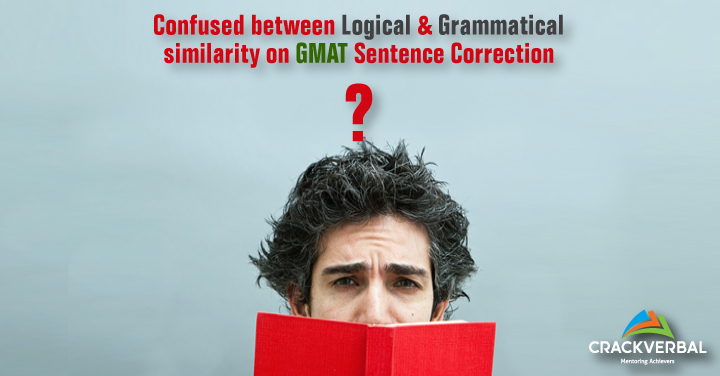Comparison questions in GMAT SC can get a little tricky because they may test not just comparisons, but often, idioms and parallelism too. In this blog let’s see how to do comparison questions.
Basic Rules for Comparison:
Which is better – a rose or a mango?
You’re probably thinking, “What a stupid question – why would you compare a flower with a fruit?” That’s exactly the point – only similar items can be compared. i.e. flowers with flowers; fruits with fruits; people with people and so on.
On the GMAT, similarity happens on 2 fronts – logical similarity (as seen above) and grammatical similarity. Let’s look at the basic rules for comparison:
Items that are compared in a list must be logically similar
The number of people having a smart phone in 1990 is less than half of 2000 X
This sentence is wrong because, we are comparing the number of people having a smart phone in 1990 to the year ‘2000’. This is an illogical comparison. How would be rewrite this sentence?
The number of people having a smart phone in 1990 is less than half of the number in 2000.
In this sentence we are comparing the number of people on both sides.
In terms of grammar, the items that are compared must be of the same part of speech. i.e. Nouns to Nouns, Adjectives to Adjectives and Verbs to Verbs.
He types faster than my typing speed.
What are we comparing here? My typing speed and his.
However, the first part of this comparison is a verb: ‘types faster’ and the second is a noun ‘my typing speed’; this is a structurally dissimilar comparison. How would we rewrite this sentence?
His typing speed is more than mine. OR
He types faster than I do.
In the first case, we are comparing typing speeds whereas in the second case, we are comparing how two people type.
OG Illustration #1:
Let’s take a look at Qn 9 from OG 13.
First, read the sentence given and identify what is being compared.
Option A: This option compares the rice production in 1979 to THOSE of the 1978 harvest. Here, A = Rice production in 1979 Ideally, B has to be rice production in 1978.
What does THOSE really refer to here? Rice production?
Can “Those” refer to “Rice production”? Certainly not, because “those” is plural and “rice production” is singular. So, A is incorrect.
Now let’s take a look at option C. Here, A = Rice production in 1979 and B = 1978. In essence, this option is comparing rice production in one year with another year (not the production in the other year) – this is illogical. So C is also wrong.
Option B, on the other hand, compares the right things. A is the rice production in 1979 and B is the ‘1978 harvest’.
Now you may be wondering – shouldn’t B be ‘rice production in 1978’? Not necessarily – 2 items need to be similar – not necessarily the same. ‘harvest’ and ‘production’ are similar quanities – so this is perfectly acceptable.
Options D and E create new errors on the question. They use the word “fewer” to talk about production, which is not a countable quantity. Can one say “fewer” production? 🙂
Looking at options D and E, we realise that sometimes the right words need to be used while making a comparison. So the obvious next question is whether there is a list of words or other idiomatic rules that apply to GMAT comparisons. We’ve attempted to compile some of the main rules:
1. When countable things are being compared use words like fewer, more and number.
2. When uncountable things are being compared use words like amount, lesser, and greater.
3. When comparing 2 items, use the comparative form of the adjective; when comparing more than 2 items, use the superlative form of the adjective.
For example:
Ram is taller than Shyam (comparative form ‘taller’)
Ram is the tallest person in the class (superlative form ‘tallest’)
4. When comparing 2 items, use ‘between’; when comparing more than 2 items, use ‘among’.
Between Ram and Shyam, Ram is taller.
Among Ram, Shyam and Ashwin, Ram is the tallest.
5. We use ‘like’ to denote similarity and ‘as’ to denote sameness.
Swapan looks like his father.
Swapan writes with his left hand, as does his father.
OG Illustration #2:
Let’s look at another example: Qn 11 from OG 13.
First, read the sentence and try to identify what is being compared. The non-underlined part of the sentence starts with James Joyce and Virginia Woolf. This means that we are comparing people. i.e. B = James Joyce and Virginia Woolf. So what should be A?
Option A: Implies that A is ‘the idolization’ – illogical comparison between ‘idolization’ and people
Option B: Same as option A
Option C: has the pronoun ‘that’ which has no legitimate antecedent. Doesn’t make sense
Option D: As what is? The meaning is ambiguous
Option E: Bingo! Compares the Brontes and the Brownings – writers – with Joyce and Woolf. i.e. people with people. Logical comparison. Hence, correct.
More Official Practice Questions:
For more practice, solve the following official questions:
OG 13: 11,24,32,43,85,98,99,108,124,125,130,136,139.
Verbal Review: 13,25,32,41,44,66,85
Happy Comparing and See you in our next blog!
Hope these techniques make a positive difference to your GMAT prep! If you’d like to share what works for you and what doesn’t, please leave a comment in the comment section below.
Head over to our E-book library for more useful information on how to achieve an awesome GMAT score!
[button href=”http://gmat.crackverbal.com/free-resources/ebook-library/” style=”emboss” size=”medium” textcolor=”#ffffff”]Explore E-Book library![/button]

